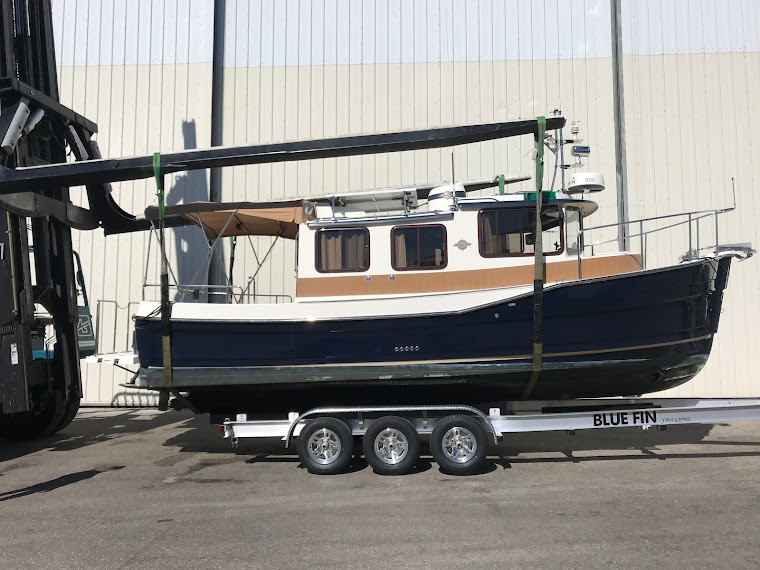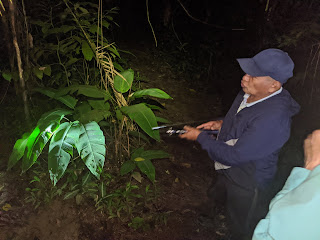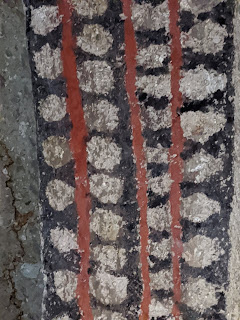Colombia
by land – Act 2 – Before the Shutdown
From
the far north in Santa Marta, we flew to Bogota for a few days to get the
flavor of the big city. An over view was
had from Monserrat – which we reached by the funicular railroad.
The
gold in the Museo del Oro, blew us away – our minds blown after only one floor
of the multi-story museum packed with literally many thousands of gold
treasures from the earlier inhabitants of this region. Some are tiny but others
are big and all are GOLDEN. just a taste.....
Our
next stop required a flight to Leticia – in the far south of Colombia on the
Rio Amazon. Colombia has a short stretch of this mighty river and a vast swath
of territory that drains into it as well. We found Leticia a bustling town with
the airport only a short ride from the central market and river dock.

Although we arrived in time to catch the noon
river boat, it was already booked out so we had to wait for the 2 PM boat. They have a unique system – one pays and
books in the office but no tickets are provided. Instead the agent calls off names as
passengers board – baggage is tossed on the roof of the boat, and we board
roughly in the reverse from the order that we will disembark. Of course, with
our limited Spanish, all of this was kind of a mystery, but we managed to make
our way to Calanoa – a “rustic” resort on the river. (We were delayed over an
hour when our boat’s engine failed and another boat had to be brought in – the
entire 60 passengers and bags had to be switched over – totally messing up our
careful seating arrangements.)
 |
| waiting room |
 |
| fast boat makes big wave |

The
normally one-and-a-half-hour trip took closer to 3 hours, but fortunately our
hotel had a man on the “dock” to welcome us and hoist our bags up the stairs to
our cabana. This resort includes seven cabanas built over the last eight years
by the owner and his crew. Diego, was in
residence for most of our stay and we enjoyed hearing the history of this
retreat and the close symbiotic relationship with the neighboring indigenous
community at Macaqua. Diego is an artist and it shows in the careful attention
to detail with artistic flare through out the compound. Although all our
comforts were attended to with generous and delicious meals, the rooms were
screened on three sides and we slept under mosquito nets. (No A/C and no fans,
but plenty comfortable.) The power was
mostly solar with a little assist from a generator so we were able to keep our
phones/cameras charged, but there was no cell service that we could connect to
or WIFI. We saw staff standing on the dock and getting a signal but it didn’t
work for us. So, our time there was a total break from the big world – where
the Covid-19 threat was brewing.


 |
| dinning "tent" |
 |
| cabana view |
 |
| boots are needed and need to stay outside |
One
our third night at dinner we met a couple who live in Thailand – Chiang Mai.
Chatting away about Thailand the gentleman said he had been a Peace Corps
Volunteer there back in the 70’s, so I asked him his group number and took a
closer look. We had actually trained
together and were both survivors of Group 42. Although we had not kept in touch
directly, we were both on the list for the previous group reunions. A small
world indeed!
Our
boat trip back to Leticia was uneventful – with a smooth transfer back to the
airport and another night in Bogota before we caught a very early flight to Neiva
– well we got to the airport for the 6AM flight, but our plane didn’t leave
until after 7 – thanks to delays caused by the weather.
 |
| time for a shave and a haircut on our way through Bogota |
In
Neiva we were met by our guide, Marino, and driver, Fred, who would be taking
care of us for the next four days. We
had a long drive through interesting agricultural areas then up mountains on
gravel and dirt roads to the area called Terradentro. Here ancient tombs were dug in the hills some
more than 5 meters deep – accessed by anywhere from 6 to 16 steps. Well, steps may not be accurate – some of
them were cliffs! Of the 30 some tombs
in the area we visited several large complexes and even entered 6 or 7. That is
Steve climbed down in most of them, and took pictures of the designs and
architecture – I only made it into a few of them not liking the “cliffs”. Our
driver dropped us off at the top of the hill and we scrambled down visiting
these amazing artifacts of the ancient residents finally arriving at the bottom
to be whisked off to our hotel.
 |
| locals using the park path to commute from school to home |
 |
| restful hotel complete with eco-friendly lawn mower |
Before
departing this area in the morning, we stopped at the museum which explained
some of the history of the area and had interesting displays of the local
culture as well.
Another
5-hour drive took us over hills and mountains to the small city of San Agustin.
Our guide informed us that the artifacts here are a big mystery. No one knows for sure who the people were who
carved the more than 600 statues which have been uncovered in the burial mounds
scattered among these hills. We spent most of one day walking the sites in the
main archeological park which is beautifully groomed and connected with shaded
paths. There are four main sites where graves and the accompanying statues are
displayed largely as they were found. Another area – called the Forest of Statues,
winds through the woods where an additional 35 statues are displayed and
protected. Some are just the bare outline – unfinished works, while others are
completed master pieces.
We
then wandered through the museum’s 9 rooms where even more, and some of the
most delicate items found in the graves were exhibited.
 |
| can you see the snakes? |
 |
| not the copy |
A
horse ride added spice to our visit – and took us to some of the outlying sites
to look a few more statues. Finally, we made a stop on our last day to see the
most recent discoveries from 1983. These statues were found to still have the
original colors – yellow, red, black and white. Since they were found on
private land, the government now allows the landowner to charge an entrance fee
to encourage their preservation.
Not
all our stops were archaeological – we enjoyed the trip to an organic coffee
plantation. Luis, the owner of the coffee plantation, gave us a personal tour
illustrating the entire process from sprouting new trees to harvesting,
fermenting, drying and husking the beans.
Of course, he made me a cup of his best coffee as well. (We also added a
few kilos to our luggage!) His passion for the organic approach was evident as
he explained all the plants that were among the different coffee varieties to
provide nutrients and shade. He even demonstrated how to start pineapples when
we asked about that process!
We
also made a short trek to see the Magdalena River Gorge. – This is the mother
river of Colombia flowing from its start in San Agustin to the mouth just a few
miles from Santa Marta. We will be
passing the mouth which is known to boaters for its width, dangerous currents,
and obstacles from debris washed down the more than 3500-kilometer length.
Around
each location we visited were the usual tourist “services” i.e. trinket vendors
and purveyors of refreshments! We occasionally had to partake – Steve enjoyed
the cheese filled arepas and I found a doll crocheted from banana fibers. We even got a few minutes to wander in the green and white town of San Agustin.....
 |
| unique B & B |
Finally, we must mention the beautiful hotel Arawanka in San Agustin - although a long walk from any town area, it was beautiful.
 |
| and restful |
 |
| a bonus, one evening we enjoyed local dancers who entertained the large tour group |
Returning
to Santa Marta, we had two hours between our flight from Pitalito to Bogota,
and our Bogota to Santa Marta flight – but leaving an hour late out of Pitalito
added some excitement to the trip. Having tickets on two different airlines
added to our connection difficulties. We flew in to Terminal 2 collected our
bags in record time and taxied to Terminal 1 for our second flight making the
gate 10 minutes before boarding. Back in Santa Marta to news of country wide
quarantines - feeling lucky to be in a lovely country, a secure marina with access to food.
Teddy liked his new accessories too!






























































































































